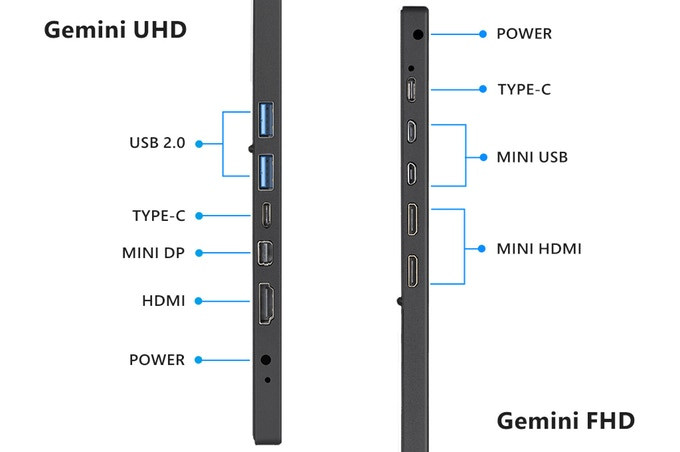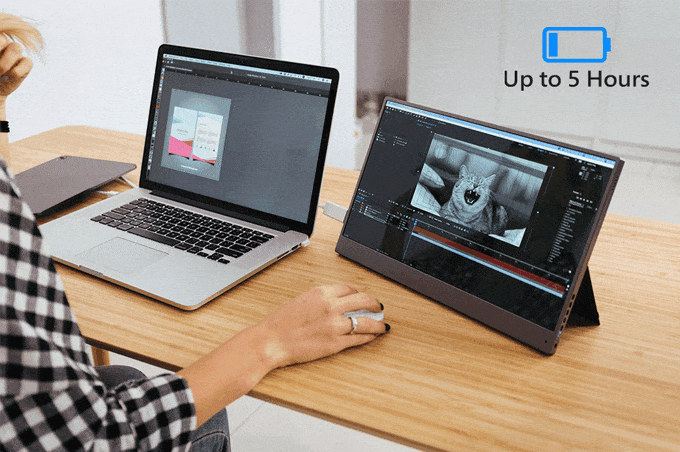Portable displays have been available for a while, but they used to be fairly heavy, as for example, Gechic On-Lap Monitor 2501M 15.6″ portable monitor weighted 1.3 kg with cover. However in recent times, we’ve seen several such products – LAPSCREEN and DUO Add-on Display – launched with lighter designs, and the advance as USB type-C and power delivery make those even more attractive since a single cable can be used to transfer video, and power both the display and the host device.
TAIHE Gemini is yet another option, but at 15.6″ is larger than the two aforementioned products, it is equipped with its own battery and kickstand, and comes in two variants with either 1920×1080 Full HD or 3840×2160 (4K UHD) resolution.
TAIHE Gemini FHD & UHD portable displays specifications:
- Display
- Gemini FHD – 15.6″ 10-point touchscreen IPS display with 1920×1080 resolution, 15ms response time, 180° kickstand
- Gemini UHD – 15.6″ IPS display with 3840×2160 resolution, 14ms response time, 180° kickstand
- Audio – Dual speakers
- Ports
- Gemini FHD – 2x mini HDMI ports, USB type-C port, 2x micro USB ports
- Gemini UHD – HDMI port, mini DP port, 2x USB 3.0 ports, USB type-C port
- Battery – 5,000 mAh good for about 5 hours
- Dimensions
- Gemini FHD – 8 mm
- Gemini UHD – 10 mm
- Weight – ~900 grams
The diagram below shows the ports for both models. The USB 2.0 ports of the UHD model will be upgraded to USB 3.0 at launch since the stretch goal was met.
 The display is meant to be used with laptops in either landscape or portrait mode, but you can also connect your smartphone, Xbox, PS4, or Nintendo Switch to play games on a larger screen, or turn Android phone into a desktop computer. Note that only Gemini FHD comes with a touchscreen, and Gemini UHD is non-touch.
The display is meant to be used with laptops in either landscape or portrait mode, but you can also connect your smartphone, Xbox, PS4, or Nintendo Switch to play games on a larger screen, or turn Android phone into a desktop computer. Note that only Gemini FHD comes with a touchscreen, and Gemini UHD is non-touch.
TAIHE Gemini has just launched on Kickstarter with a $10,000 funding target. But the demand for the display has been great so far, with close to $500,000 raised from around 1,700 backers at the time of writing. You can now pledge $189 to get an early bird Gemini FHD touchscreen display, and $299 for the Gemini UHD display. Adding $15 will get you a sleeve to safely store your display. Shipping adds $25 worldwide, and you should be expecting your reward(s) around May 2019.
Via Liliputing

Jean-Luc started CNX Software in 2010 as a part-time endeavor, before quitting his job as a software engineering manager, and starting to write daily news, and reviews full time later in 2011.
Support CNX Software! Donate via cryptocurrencies, become a Patron on Patreon, or purchase goods on Amazon or Aliexpress






Their marketing team needs to be replaced. The first photo shows a white-and-black miniature video on the display, which really isn’t an appealing way to promote an external display. And moreover they couldn’t avoid hideous glares on the screen, making one figure there’s really no way to get a pleasant experience with it. Ah and on the promotion video they managed to write “Andriod” on the logo 🙂 All of this looks a bit rushed and doesn’t make me expect a slightest bit of consideration for quality from there.
> Ah and on the promotion video they managed to write “Andriod” on the logo
Maybe not even a mistake… just the try to ensure that people who care about details are scared away immediately (similar to the way spam in our inboxes is ‘designed’ –> to ensure only really clueless people will click on the links).
Another funny detail is the constant switch between a Chromebook and a MacBook (see e.g. at 1:40 in the video) suggesting that certain gesture features like zooming in would also work when running on a MacBook with macOS.
I’ve not had a problem with my Asus with my laptop. I’m thinking about trying out one of the USB C upgraded ones, even though I’ve got an older laptop to see what happens. The current unit I’ve got works great, though mainly use it with windows and sometimes with a mac laptop.
Nice, but why not just buy the “ASUS MB169B+ 15.6″ Full HD 1920×1080 IPS USB Portable Monitor” for 189 USD at Amazon? Easier and safer (with the Asus + Amazon brand names)
The Asus MB169B is not an external HDMI/DP display but USB3 attached via DisplayLink — just use a search engine with this term to get an idea about all the stuff DisplayLink is ‘famous’ for: artifacts, delays, driver hassles and so on…
That was my question i was about to ask… Everywhere only written about a single USB cable, no further info about alternate modes etc…
> Everywhere only written about a single USB cable
With USB-C ‘single USB cable’ wouldn’t be an issue (since this is the main invention with USB-C: one cable to transport power, data and display output at the same time without additional wiring). But if ‘USB3’ is mentioned as protocol you already know that it’s not about one of the 5 defined Alternate Modes all providing flawless display output via USB-C but something proprietary.
Some more info on DisplayLink: https://www.cnx-software.com/2017/02/03/targus-universal-displaylink-docking-stations-support-up-to-six-4k-monitors-via-a-single-usb-cable/
Display has already battery support for making it a handy wireless display with AirPlay2, Google cast/Google home/Chromecast or Miracast support. For Screen Mirroring (Samsung) or Multiroom (Apple) and Microsoft Continuum streaming support (Miracast).
Usb-C is a battery charging/power backup and 2nd data transfer option for a portable display at this size.
On rural areas at developing countries Usb-C even replaces main power supply to some extent. That’s progress there for safety and cost saving, some combined with solar power.
Didn’t find USB-C in India other than as a charging port on a mobile. I know India is quickly changing, but I doubt they changed the mains from 240V to USB-C in the last 3 months…
Honestly why would you want to have a non graphics oriented connection to a pure display? Worst case mhl, if that still exists… Else DP, HDMI, USB-C w/ some alternate mode or DVI when space permits.
I don’t know that I would want an external HDMI display like this. The external ASUS and the like are just powered off the laptop (must have power to do that), and with power supply operation, there’s not limit on operating it.
I don’t do much of anything which I need a standalone powered display with need to recharge. I’m guessing there are people who do things out and about away from power, but my use case with a laptop is to be set up near power and net services, and have a portable light computer (and possibly an extra display).
my most frequent use of battery power is when I have problems in my computer pile is to just pick up the laptop and walk into where the systems are and have the system right there, but I usually go back to where I work and reconnect to power there.
I’ve not had a problem with my Asus with my laptop. I’m thinking about trying out one of the USB C upgraded ones, even though I’ve got an older laptop to see what happens. The current unit I’ve got works great, though mainly use it with windows and sometimes with a mac laptop.
> I’ve not had a problem with my Asus with my laptop.
Still the Asus unlike the above display uses DisplayLink which is something entirely different than DisplayPort (USB-C Alternate mode). The latter will always work, the former needs a driver and doesn’t deal that great with dynamic display updates at higher resolutions by design. See this comment and the two last ones: https://www.cnx-software.com/2017/02/03/targus-universal-displaylink-docking-stations-support-up-to-six-4k-monitors-via-a-single-usb-cable/#comment-538703